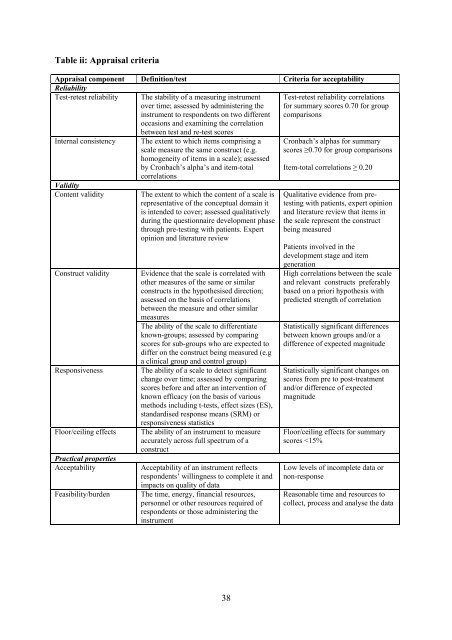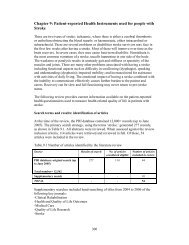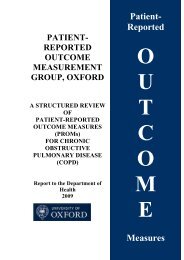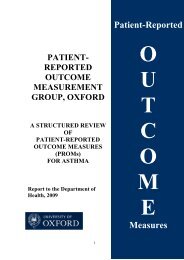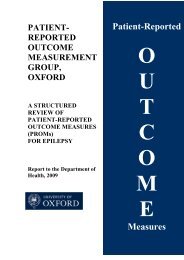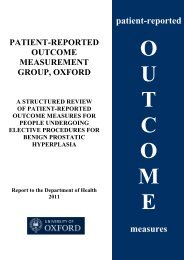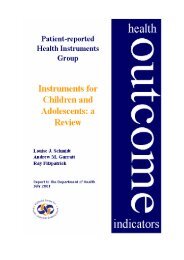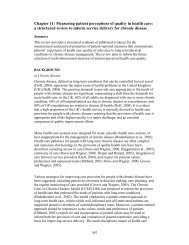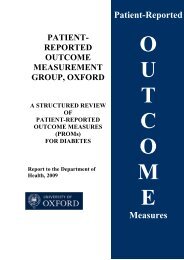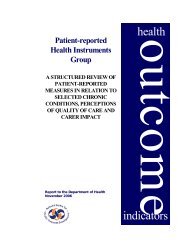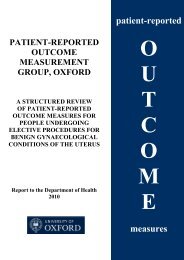2010 review - Patient-Reported Outcomes Measurement - University ...
2010 review - Patient-Reported Outcomes Measurement - University ...
2010 review - Patient-Reported Outcomes Measurement - University ...
Create successful ePaper yourself
Turn your PDF publications into a flip-book with our unique Google optimized e-Paper software.
Table ii: Appraisal criteria<br />
Appraisal component Definition/test Criteria for acceptability<br />
Reliability<br />
Test-retest reliability The stability of a measuring instrument<br />
over time; assessed by administering the<br />
instrument to respondents on two different<br />
occasions and examining the correlation<br />
between test and re-test scores<br />
Internal consistency The extent to which items comprising a<br />
scale measure the same construct (e.g.<br />
homogeneity of items in a scale); assessed<br />
by Cronbach’s alpha’s and item-total<br />
correlations<br />
Validity<br />
Content validity The extent to which the content of a scale is<br />
representative of the conceptual domain it<br />
is intended to cover; assessed qualitatively<br />
during the questionnaire development phase<br />
through pre-testing with patients. Expert<br />
opinion and literature <strong>review</strong><br />
Construct validity Evidence that the scale is correlated with<br />
other measures of the same or similar<br />
constructs in the hypothesised direction;<br />
assessed on the basis of correlations<br />
between the measure and other similar<br />
measures<br />
The ability of the scale to differentiate<br />
known-groups; assessed by comparing<br />
scores for sub-groups who are expected to<br />
differ on the construct being measured (e.g<br />
a clinical group and control group)<br />
Responsiveness The ability of a scale to detect significant<br />
change over time; assessed by comparing<br />
scores before and after an intervention of<br />
known efficacy (on the basis of various<br />
methods including t-tests, effect sizes (ES),<br />
standardised response means (SRM) or<br />
responsiveness statistics<br />
Floor/ceiling effects The ability of an instrument to measure<br />
accurately across full spectrum of a<br />
construct<br />
Practical properties<br />
Acceptability Acceptability of an instrument reflects<br />
respondents’ willingness to complete it and<br />
impacts on quality of data<br />
Feasibility/burden The time, energy, financial resources,<br />
personnel or other resources required of<br />
respondents or those administering the<br />
instrument<br />
38<br />
Test-retest reliability correlations<br />
for summary scores 0.70 for group<br />
comparisons<br />
Cronbach’s alphas for summary<br />
scores ≥0.70 for group comparisons<br />
Item-total correlations ≥ 0.20<br />
Qualitative evidence from pretesting<br />
with patients, expert opinion<br />
and literature <strong>review</strong> that items in<br />
the scale represent the construct<br />
being measured<br />
<strong>Patient</strong>s involved in the<br />
development stage and item<br />
generation<br />
High correlations between the scale<br />
and relevant constructs preferably<br />
based on a priori hypothesis with<br />
predicted strength of correlation<br />
Statistically significant differences<br />
between known groups and/or a<br />
difference of expected magnitude<br />
Statistically significant changes on<br />
scores from pre to post-treatment<br />
and/or difference of expected<br />
magnitude<br />
Floor/ceiling effects for summary<br />
scores


